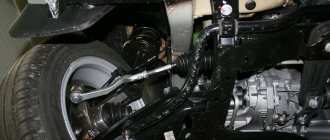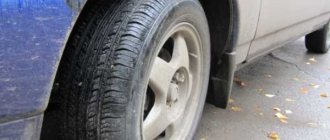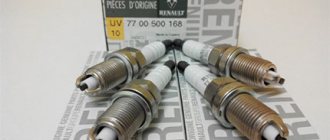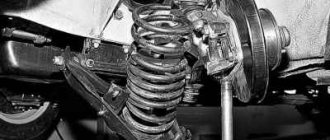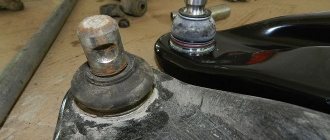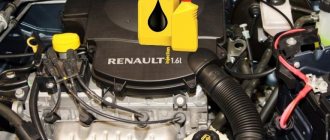Front suspension device Lada Largus
So, the front suspension of the Lada Largus has a similar structure to the Renault Logan MPV van, since the entire car was made entirely on its basis. In fact, the front suspension is independent of the MacPherson type and is built around a full-fledged subframe, which has not been done on the Lada before. Shock absorbers are conventional telescopic gas-oil, springs are cylindrical screw.
Below are the right and left levers on two silent blocks and a ball, as well as a stabilizer bar.
The subframe itself is attached to the side member of the engine compartment and the power units of the engine shield using bolts.
In essence, the design of the front suspension on the Lada Largus is as simple as possible, but as reliable and efficient as possible, which makes servicing this unit inexpensive and fast.
Below in the diagram you can see how the front suspension on your Lada Largus is designed.
Electrics are a weak point
With daily use, headlights wear out within two to three years. There is no point in doing restoration: old optics cannot be saved, and new ones will cost the price of polishing. The same two or three years are given to the wiring that is laid from the body pillars inside the rear hinged doors - the wires simply break.
The sound signal is located on the steering column lever. And the levers themselves are of poor quality: because of this, the first speed wipers chronically do not work on many cars. The electrical equipment is made from the cheapest components. Therefore, there were, are and will be problems.
Front suspension arms Lada Largus
The front suspension design of Largus uses two triangular arms - right and left. They are based on two silent blocks that secure the lever to the subframe, as well as one ball joint connecting the lever and the steering knuckle. This is one of the most vulnerable components of the Largus front suspension, as it takes all the impacts, as a result of which the ball joint breaks and the silent blocks wear out.
In early Lada Largus models, the ball joint was changed separately, and in relatively new ones - only together with the lever. Silent blocks can be changed without problems and buying them is not difficult.
Article numbers of the front levers: 6001547520 (left, assembled) 6001547519 (right, assembled).
Conclusion
Of course, detailed diagnostic procedures and timely elimination of the causes of the malfunction will allow you to quickly repair the suspension. In this matter, it is better to trust the specialists of service centers, who will help prevent major repairs by replacing some components or tightening the connections that secure them.
Sources
- https://LargusCenter.ru/remont/podveski-ladyi-largus.html
- https://prometey96.ru/lada-remont/podveska-largus.html
- https://ZamenaRenault.ru/largus/podveska-i-rul/podveska-lada.html
- https://wiki.zr.ru/40_Largus
- https://largus-shop.spb.ru/helpful/item/2647-khodovaya-lada-largus
- https://labavto.com/vaz/lada-largus/remontiruem-samostoyatelno-podvesku-lada-largus/
Front suspension subframe Lada Largus
The Lada Largus subframe is a stamped-welded square that serves as a frame for the remaining elements of the front suspension. The subframe is attached to the body with 4 bolts, and at the rear the subframe has fasteners for the anti-roll bar. Also at the edges, levers are attached to the subframe with two bolts on each side. The subframe looks like this:
Renault engines are strong hardware
At first, French eight- (K7M) and sixteen-valve (K4M) 1.6 engines were installed on Largus. These units, known from Logans and Sanderos, are famous for their service life of about 400,000 km. If the engine falls apart before the car, it is easier and cheaper to buy a contract unit. It’s realistic to buy it for 50–60 thousand rubles, but for a proper overhaul they’re now asking around a hundred. And it’s not a fact that they will do it well.
We will disappoint those who like to install everything new. For K4M, sellers want as much as 300 thousand rubles, and this is without attachments. At the same time, a brand new cylinder block is sold for 15,000 rubles, and a head for 50,000 rubles. If you decide to overhaul, buy plug-in pistons that do not interfere with the valves if the timing belt breaks. In the eight-valve model, the belt lasts 60,000 km, and in the older version - 120,000 km. We also recommend investing in rollers and a cooling system pump.
The eight-valve engine suffers from oil leakage through the front crankshaft oil seal - keep an eye on the level on the dipstick. Every hundred thousand, the valves need to be adjusted - here the French saved on hydraulic compensators. Although the sixteen-valve engine has hydraulic cups.
With age, the ignition coil insulators dry out, and the crankcase ventilation system becomes overgrown with dirt. To prevent lubricant from starting to flow through the receiver, the system must be cleaned. A tiny air filter becomes clogged with dust after 8–10 thousand km, after which the car stops driving. You can ignore the squeaking of the suspension belt rollers - this is more of a proprietary feature than a malfunction, just like the ever-leaking valve cover.
But failure of the crankshaft position sensor and thermostat is a problem. Both are considered almost consumables and do not shine with quality.
Front suspension shock absorber Lada Largus
The front suspension shock absorber (or strut) is attached to the steering knuckle from below with two bolts and from above through a support to the wing cup. Serves to absorb shocks from the suspension, ensuring a smooth ride. For a smooth return to the starting position, a coil spring with the same pitch of turns is used. Just like the lever, the shock absorber is subject to wear, as it takes impacts from the wheels.
Replacing the front strut does not present any difficulty, as we wrote about in one of our articles.
Main symptoms of malfunctions
Over the course of operation, chassis elements are subject to continuous wear. Its degree is influenced by driving style and, most importantly, by the condition of the roads. Failed parts can manifest themselves in different ways. Among the first signs are knocking noises, and experienced mechanics can determine by the nature of this sound which component of the system should be suspected of malfunction. Also, a worn suspension is characterized by squeaks, vibration and instability. We should not forget about leaks of working fluids from the cavities of the shock absorber struts.
Anti-roll bar Lada Largus
This unit serves to reduce body roll and sway when turning and sharply changing lanes. It is a rod made of elastic metal that works in torsion. Attached to the subframe through bushings and to the right and left arms through special stabilizer struts. The struts and bushings are consumable parts that need to be replaced when worn. The stabilizer itself very rarely requires replacement.
Vertical body swing
This situation arises due to loss of rigidity by spring elements or failure of a shock absorber (several). The malfunction occurs during acceleration, intense deceleration, and when entering sharp turns at speed. Here the LADA Largus car rolls, trying to move from the given trajectory. You should also pay maximum attention to the transverse stabilizer. Due to the wear of its struts, a significant loss of efficiency can occur (also manifested at high speeds in corners). An effective remedy would be to diagnose and replace the required parts.
Contents of delivery
The air suspension kit is designed specifically for the car and includes two pneumatic elements, brackets for mounting to the frame and axle, fasteners, fittings for inflation from an external compressor, and instructions for do-it-yourself installation.
The kit includes:
- American bellows-type pneumatic elements (air springs), which are optimally sized for a given vehicle. They do not require any maintenance due to the reliable rubber-cord construction and last for more than 400 thousand vehicle mileage in any road conditions.
- fastening elements of our own factory production from 6mm Russian steel, developed specifically for this car. These brackets are reliable, easy to install and will last a long time. The brackets are powder coated, which protects them from rust throughout their entire service life.
- a set of Russian bolts, washers, nuts for assembling the kit
- air fittings and pneumatic line from Camozzi, the kit includes 7 meters of pneumatic hose, which allows you to install the inflation nipple in any part of the car
- nipple for deflation and inflation with any external AirLift compressor
- installation instructions
- All equipment has been tested under various conditions, which gives us confidence in the reliability of this air suspension kit. The kit comes fully disassembled with step-by-step installation instructions. Unlike our competitors, we do not hide what the kits are made of and allow the client to independently familiarize themselves with all the fasteners during installation to ensure their reliability and ease of installation.
Gearboxes - manual only
The French eight-valve engine will be paired with a 5-speed manual JH3. It does not tolerate tight driving when the driver engages fifth gear almost at idle. This manner overloads the input shaft bearing-oil seal and the unit can howl after 70,000 km. Use only the original bearing as a replacement: analogues last three times less.
The inner boot of the left drive also plays the role of a gearbox seal. And after a while oil begins to leak from here. If you miss the moment, the transmission will be left without lubrication at all. Therefore, urgently buy a repair kit and three liters of transmission.
With the departure of the eight-valve K7M, there was only one box left - JR5. It is even more reliable, but both units have a unit that combines the working cylinder and the clutch release bearing. It usually has to be changed after 50,000 km. Installation requires skilled hands, otherwise there is a chance of breaking off the fragile pipe under the hydraulic line.
Another common problem is the frankly short fifth gear, which can lead to excessive consumption of gasoline. If you wish, you can correct this miscalculation by replacing a pair of gears, and skilled craftsmen will perform the operation without removing the box.
VAZ engines are less reliable
Since the end of 2015, the 87-horsepower VAZ eight-valve 1.6 (VAZ-11189) has been installed on Largus. It is a little more powerful, more torquey and more economical. The resource reaches a quarter of a million kilometers. But there are just small jambs behind the VAZ engine - apparently and invisible! Moreover, it will not be possible to sort all the disadvantages into categories - each collected copy is individual.
Only a large loss of oil in the first thousand kilometers is a common feature. Then, as soon as the parts are broken in, the oil burn will go away and fuel consumption will become less.
The biggest problem with VAZ engines is poor-quality belts. Therefore, be sure to inspect the drive at a mileage of 60,000 km, although the manufacturer, according to regulations, recommends driving up to 75,000 km. Since 2021, AVTOVAZ has introduced “stickless” pistons - belt breakage is no longer so scary.
